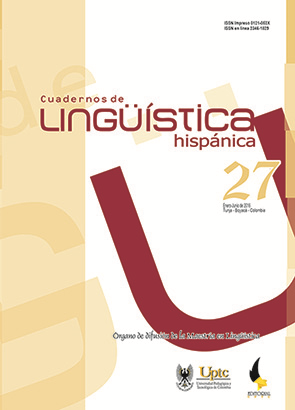Exploring critical television literacy skills in a tenth graders’ classroom

Abstract
This study was aimed at providing tenth graders with spaces and activities to develop critical television literacy skills. This was the first time that students at Antonio Nariño School in Moniquirá, were involved in the analysis of TV programs. Therefore, this activity allowed them to establish a new type of interaction between the TV programs and their personal and familiar worlds. A descriptive case study was conducted and the data analysis reported that teenagers are in a process of building up their personalities and identities. In this process, they ask their closer realities and identify in the sitcoms representations of the reality and spaces to learn about academic issues as well as guides to solve daily life problems.
Keywords
Critical Media Literacy, Critical Television Literacy, Teenagers.
References
- Aguirre, A. (1998). Psicología de la Adolescencia. Bogotá: Alfa omega. Marcombo.
- Buckingham, D., Banaji, S., Burn, A., Carr, D., Cranmer, S., & Willet, R. (2004).The Media Literacy of Children and Young People. Retrieved from htpp://www.ofcom.org.uk/advice/media_literacy/medlitpup/medlitpubrss/ml_children.pdf
- Considine, D. (2002). Critical Viewing and Critical Thinking Skills. Retrieved from http://eric.ed.gov/ERICWebPortal/Home.portal?_nfpb=true&ERICExtSearch_SearchValue_0=EJ602601&ERICExtSearch_SearchType_0=eric_accno&_pageLabel=RecordDetails&accno=EJ767019&_nfls=false&objectId=0900019b801728fe
- Creel, M., & Orozco, G. (1990). Educación para la Recepción: Hacia una Lectura Crítica de los Medios. México: Trillas.
- Ferreiro, E. (2003). Past and Present of the verbs to Read and to Write. Toronto: GroundwoodBooks.
- Ferres, J. (1994). Televisión y Educación. Barcelona: Paidós Editores.
- Freeman, D. (1998). Doing Teacher Research: From Inquiry to Understanding. Canada: Heinle and Heinle Publishers.
- Freire, P., & Macedo, D. (1987). Literacy: Reading the Word and the World. Westport, Connecticut: Bergin & Garvey.
- Goldthorpe, J. (1993). Talking Back to TV: Media Literacy and Writing.Paper presented at the Annual Meeting of the Conference on College Composition and Communication (44th, San Diego, CA, March 31- April 3). Retrieved from http://www.eric.ed.gov/ERICWebPortal/custom/portlets/recordDetails/detailmini.jsp?_nfpb=true&_&ERICExtSearch_
- SearchValue_0=ED363880&ERICExtSearch_SearchType_0=no&accno=ED363880
- Harmer, J. (2007). How to teach English. Malaysia: Longman.
- Hobbs, R. (1998). The seven great debates in the media literacy movement. Journal of Communication, 48, 16-32. DOI: https://doi.org/10.1111/j.1460-2466.1998.tb02734.x
- Horrocks, J. (1990). Psicología de la Adolescencia. México: Trillas.
- Kuan, Ch. (2007). Media programs like hip-hop. Retrieved from http://eric.ed.gov/ERICWebPortal/Home.portal?_nfpb=true&ERICExtSearch_SearchValue_0=EJ602601&ERICExtSearch_SearchType_0=eric_accno&_pageLabel=RecordDetails&accno=EJ767019&_nfls=false&objectId=0900019b801728fe
- Kucer, S. (2001). Dimensions of Literacy. A conceptual Base for Teaching Reading and Writing in School Settings. Mahwah, New Jersey. London: Lawrence Erlbaum Associates, Publishers.
- Kumaravadivelu, B. (2006). Understanding language teaching from method to post-method. London: Lawrence Erlbaum Associates, Publishers. DOI: https://doi.org/10.4324/9781410615725
- Lawrence, J., Gagnon, W., Godin, R., Ledbetter, C., & Fehlman, R. (1993).The Round Table: Television in the English Curriculum. The English Journal, 82, 6, 77-79. Retrieved from http://links.jstor.org/sici?sici=00138274%28199310%2982%3A6%3C77%3ATRTTIT%3E2.0.CO%3B2X.
- Merriam, S. (1991). Case Study Research in Education: A qualitative Approach. San Francisco. Oxford: Jossey-Bass Publishers.
- Moreno, C. (2003). El Mundo de los Adolescentes. México: Trillas.
- Shaw, D. (2003). A Plea for Media Literacy in our Nation’s Schools. Retrieved from http://www.medialit.org/reading_room/article631.html
- Short, K. (2001). Curriculum as inquiry: Inquiring into inquiry by examining our beliefs and practices. Colombian Applied Linguistics Journal, 3, 21-31.
- Tisdell. E., Stuckey, H., & Thompson, P. (2007). Teaching critical media literacy in higher and adult education: An Action Research Study. Retrieved from http://www.oise.utoronto.ca/CASAE/cnf2007/proceedings2007/AERC%20CASAE%20Tisdell%20Stuckey%20Thompson-2007.pdf
- Vásquez, T., Pinilla, V., Robayo, J., Cárdenas, P., & Martínez, L. (2006). La Televisión en la Familia y la Familia en la Televisión. Estudios de Audiencias Socioculturalmente diferenciadas. Bogotá: Publicaciones Comisión Nacional de Televisión.